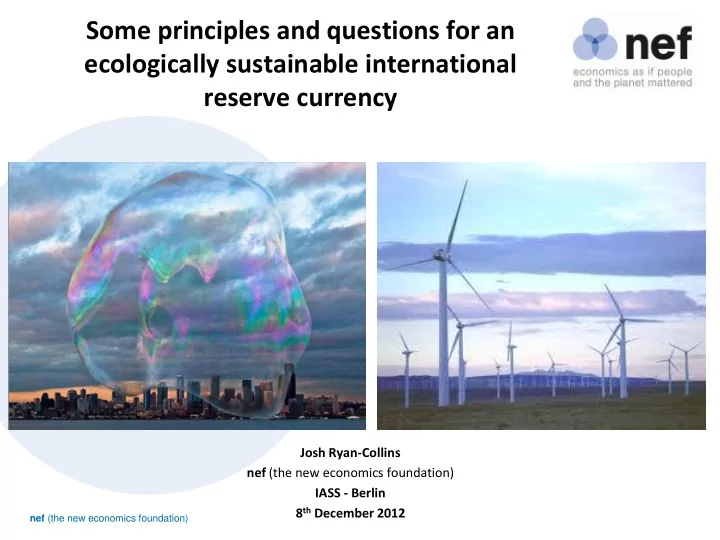

Some principles and questions for an ecologically sustainable international reserve currency Josh Ryan-Collins nef (the new economics foundation) IASS - Berlin 8 th December 2012 nef (the new economics foundation)
Contents • Problems with modern money • Some recent relevant proposals • Questions for research nef (the new economics foundation)
Flaws of the modern monetary system (and principles of a new system) ‘Virtual’ wealth – the problem of compound interest allowing monetary ‘wealth’ to diverge from the productive capacity of the economy Un-economic growth – structural drivers of monetary growth beyond ecological limits (Herman Daly) Dysfunction – conflict between ‘store of value’ and ‘means of exchange’ functions Discounting the future – undervaluing future wealth in economic decision-making Mis-allocation – lack of incentives for money to be created for investments that create ecological and social value Financial instability – the problem of money creation for speculative rather than productive use Global and regional imbalances ‘Trickle up’ capital flows nef (the new economics foundation)
Money & economy: conventional, anthropocentric production process � nef (the new economics foundation)
Real world: non-substitutability of resources & wastes � nef (the new economics foundation)
Detachment of money supply from real economy nef (the new economics foundation)
Banks moving away from productive investment U.K. banks net lending by sector, 1997- 2010, sterling millions Source: Bank of England Statistical Database and Positive Money nef (the new economics foundation)
Poorer countries lending to the world’s richer countries Net flows of capital; Funds predominantly from energy & commodity export earnings Source: UN (2010) in Douthwaite 2011 nef (the new economics foundation)
Strong relationship between resource price increases and national deficits rising Spain Italy Portugal France current account deficit of 4th 7.47 6.27 1.81 10.69 quarter 2011 in bn. € increase in resource import costs between 1st quarter 2.34 5.29 0.35 7.77 2009 and 4th quarter 2011 in bn. € share of this increase in current account deficit of 4th 31 % 84 % 19 % 73 % quarter 2011 Sven Giegold , ‘Saving the Euro needs a Green New Deal’, INET, 4 th May 2012 nef (the new economics foundation)
A solution for Europe: Varoufakis (2012) nef (the new economics foundation)
World Future Council SDR proposal (2012) • £100bn SDRs created dedicated to green projects • new funding not inflationary as issued only against performance, i.e. to produce new goods and services with (mostly) unused productive capacities and unemployed labour. • IMF member states agree on the issuance of new SDRs to themselves but must commit in advance to putting majority at the disposal of new Climate Fund. small portion (e.g. 10% – 20%) allocated to them to finance agreed national climate protection projects. • Climate fund change the newly obtained SDRs into the required national currencies at the respective central banks, when they are required to pay for agreed climate projects, e.g. renewable energy plants. • use and control of this new money coordinated by the Global Environment Facility, UNEP, UNDP or new Green http://www.worldfuturecouncil.org/4828.html Climate Fund of the UNFCCC. nef (the new economics foundation)
C&C/ Energy backed currency unit (ebcu) & Special Emissions Rights (SERS) (Douthwaite 1999) • “an international currency should be linked to the availability of the scarcest global resource so that, since people always try to minimise their use of money, they automatically minimise their use of that scarce resource .” • SERs and ebcus issued by IMF and allocated to national governments on a per capita basis, quantity continuously decreasing (according to C02 reduction targets). SERs issued annually, ebcus issued only once. • Ebcus become only currency that could be used for foreign trade. Countries could buy & sell ebcus from other nations – exchange rates between national currencies and ebcus would emerge • If a government used ebcus to buy additional SERs from the IMF in order to be able to buy more fossil energy, the IMF would cancel ebcus, & circulation internationally would fall. i.e. IMF's obligation to supply additional SERs would be strictly limited by the amount of ebcus it put into circulation. ebcus in circulation ebcu energy prices, cutting level of economic activity – i.e. national economies could only expand at rate they became more fossil-energy efficient. • Interdependencies between the currencies provide automatic feedback and a self-adjustment of the relative quantities, values and exchange rates: currency itself would give a nation the respective market signal to switch to the path of a low-carbon economy. As ebcu would be used for foreign trades, a relatively weak national currency, in relation to the ebcu, would trigger and support a more efficient use and import substitution of fossil energy, while along this path the national currency would be revalued again. • Douthwaite’s hope was that, “[u] nder this system, countries would control their economies by adjusting the energy supply rather than the credit supply as they do today.” nef (the new economics foundation)
Questions for further research • Interactions between these proposals and: – national banking systems – International finance esp. ‘shadow banking’ • Governance issues: who decides on allocation of funds for projects • Evaluation framework to ensure stability and longevity nef (the new economics foundation)
"There is no good reason for a community to be without money. To be short of money when there's work to get done is like not having enough inches to build a house. We have the materials, the tools, the space, the time, the skills and the intent to build … but we have no inches today? Why be short of inches? Why be short of money?" Michael Linton, LETS creator nef (the new economics foundation)
More information josh.ryan-collins@neweconomics.org @jryancollins www.neweconomics.org/projects/monetary-reform nef (the new economics foundation)
Recommend
More recommend